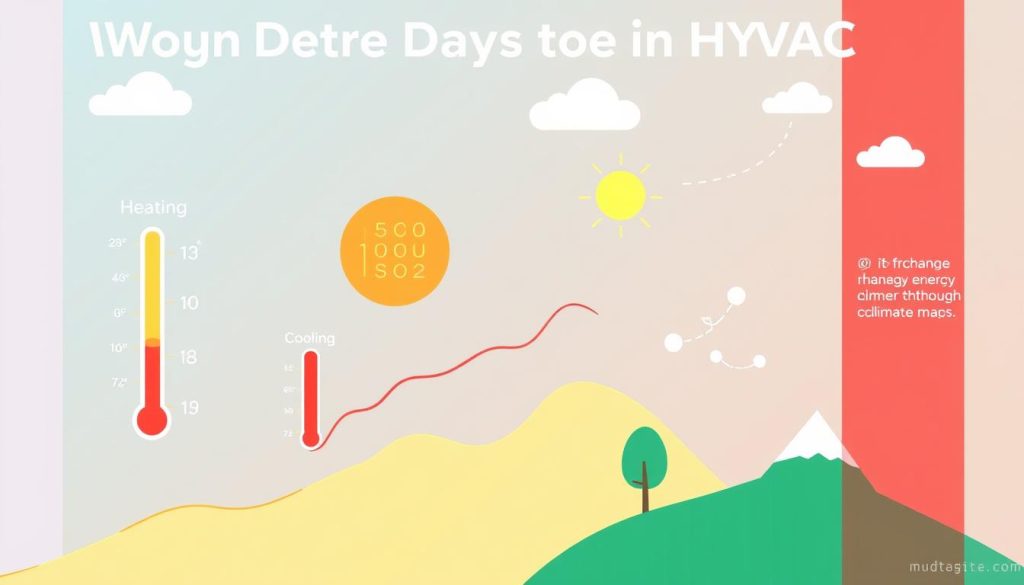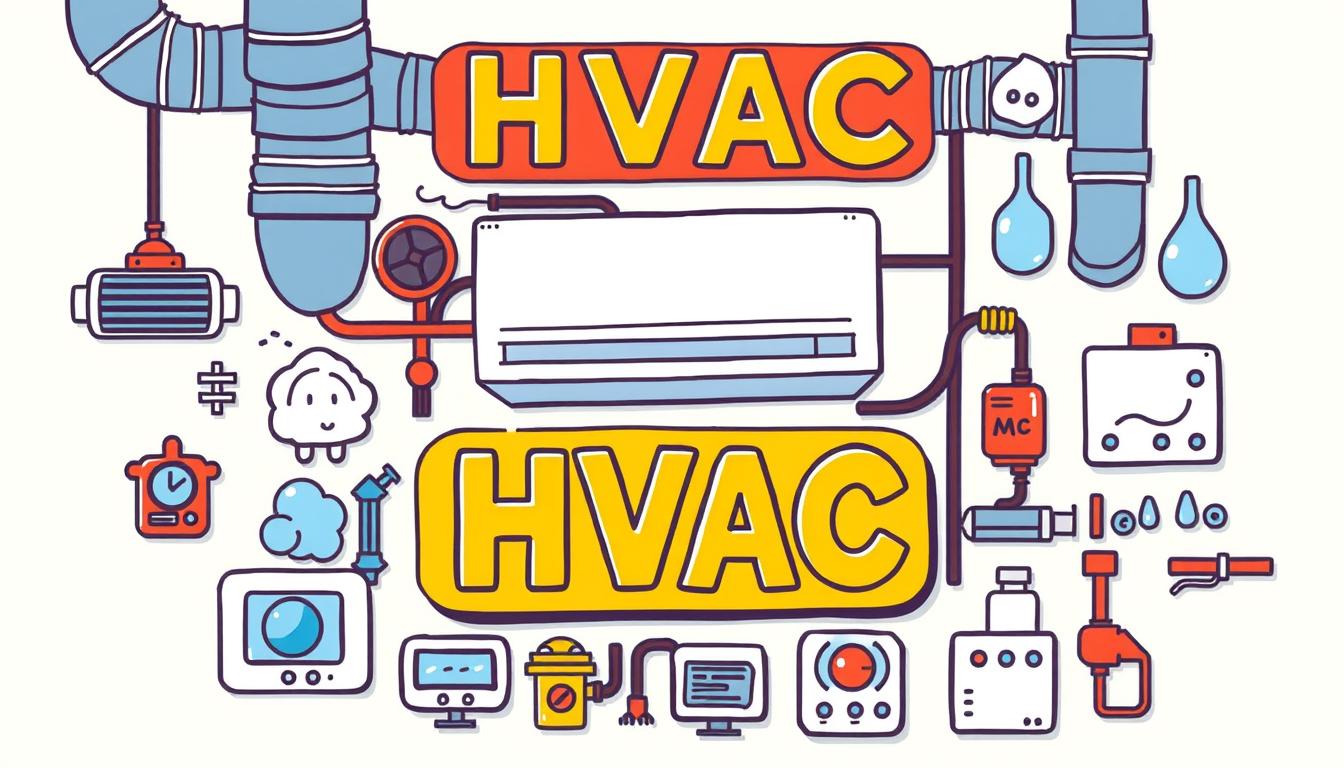In the HVAC world, “dd” means “degree days.” It’s key for knowing how much energy a building needs to stay comfy. It shows the demand for heating and cooling.
Degree days are figured out by subtracting the average daily temperature from 65°F (18°C). This is the temp where no heating or cooling is needed. Then, this difference is added up over a set time, like a day or month, to find the total degree days.
Tracking degree days helps HVAC experts guess how much energy a building will use. This info is super useful for designing better systems and saving energy. It helps keep people comfortable without using too much energy or money.
Key Takeaways
- The abbreviation “dd” in HVAC stands for “degree days,” a metric used to quantify the demand for heating or cooling a building.
- Degree days measure the difference between the average daily temperature and a reference temperature, typically 65°F (18°C).
- Tracking degree days helps HVAC professionals estimate energy consumption and operating costs, enabling them to optimize system design and efficiency.
- Understanding degree days is crucial for maintaining a comfortable indoor environment while minimizing energy usage and costs.
- Degree days are an important concept in the HVAC industry, as they provide valuable insights for improving system performance and energy management.
What does dd mean in HVAC?
In the world of HVAC (Heating, Ventilation, and Air Conditioning), “dd” means “degree days.” This HVAC terminology is key to knowing how much energy heating and cooling systems need.
Heating Degree Days
Heating degree days (HDD) measure how cold it is outside. They show how many degrees below 65°F (18°C) it is for how many days. The more HDD, the more energy needed to heat buildings in winter.
Cooling Degree Days
Cooling degree days (CDD) measure how warm it is outside. They show how many degrees above 65°F (18°C) it is for how many days. The more CDD, the more energy needed to cool buildings in summer.
Calculating degree days is vital for HVAC planning and design. It helps figure out the right size and efficiency of heating and cooling equipment for a place.
Knowing HVAC terminology and the importance of degree days is crucial. It helps make smart choices about HVAC systems and their energy use.
Importance of Degree Days in HVAC
In the world of HVAC (Heating, Ventilation, and Air Conditioning), degree days are key. They help figure out how much energy a building’s heating and cooling systems use. These HVAC terms and HVAC abbreviations show how outdoor temperature affects indoor comfort.
Energy Consumption Estimates
Tracking degree days helps HVAC experts guess how much energy a building needs. They use heating degree days and cooling degree days to size equipment and save energy.
For instance, a lot of heating degree days in winter means the HVAC system works harder. This leads to more energy use and costs. In summer, a lot of cooling degree days means more energy to keep it cool inside.
Knowing HVAC terminology and HVAC lingo helps pros design better systems. This cuts down on energy consumption and energy estimates for clients.
| Metric | Description | Calculation |
|---|---|---|
| Heating Degree Days (HDD) | A measure of how much (in degrees), and for how long (in days), the outside air temperature was below a reference temperature, which is often 65°F. | HDD = (Reference Temperature – Actual Temperature) x Days |
| Cooling Degree Days (CDD) | A measure of how much (in degrees), and for how long (in days), the outside air temperature was above a reference temperature, which is often 65°F. | CDD = (Actual Temperature – Reference Temperature) x Days |

HVAC Terminology and Abbreviations
Understanding hvac terms, hvac abbreviations, hvac jargon, hvac terminology, hvac lingo, hvac definitions, hvac acronyms, hvac glossary, and hvac technical terms is key in the HVAC world. These words and acronyms are the industry’s language. They help HVAC pros talk clearly and get things done.
Here are some common hvac terms you might see:
- AC – Air Conditioning
- AFUE – Annual Fuel Utilization Efficiency
- BTU – British Thermal Unit
- CFM – Cubic Feet per Minute
- COP – Coefficient of Performance
- SEER – Seasonal Energy Efficiency Ratio
Knowing these hvac abbreviations and hvac acronyms helps you understand system data. It also lets you talk better with HVAC techs. And it helps you make smart choices about your HVAC system.
| HVAC Term | Definition |
|---|---|
| Air Handler | A device used to circulate and condition air as part of a heating or cooling system. |
| Condenser | The outdoor unit of a central air conditioning system that releases heat from the refrigerant. |
| Ductwork | The system of ducts that deliver and return air in an HVAC system. |
| Evaporator | The indoor coil of a central air conditioning system that absorbs heat from the air. |
Learning these hvac terms, hvac lingo, and hvac definitions makes navigating the HVAC world easier. It lets you talk better with HVAC pros. And it helps you make smart choices about your heating and cooling needs.
Duct Design and Zoning
The HVAC system’s ductwork is key to its efficiency and performance. Proper sizing, layout, and airflow management are vital. This ensures even temperatures and reduces energy loss. HVAC zoning is a solution that tackles these issues.
HVAC Zoning: Tailored Comfort
HVAC zoning divides a building into climate-controlled areas. This lets occupants adjust temperatures and airflow in specific zones. It offers several benefits:
- Improved Energy Efficiency: It reduces energy use and costs by only heating or cooling occupied spaces.
- Enhanced Comfort: People can set their own comfort levels, making the environment more pleasant.
- Flexibility: It makes it easy to change a building’s layout or use without affecting the HVAC system.
Dual Duct Systems: Versatile Climate Control
Dual duct systems are a type of HVAC zoning. They use separate ducts for hot and cold air, allowing for independent control in different zones. They have several benefits:
- Precise Temperature Management: Each zone can have its own temperature without affecting others.
- Improved Indoor Air Quality: The separation of air streams can improve air circulation and quality.
- Adaptability: Dual duct systems are very flexible, making it easy to adjust to changing needs.
Understanding duct design and HVAC zoning can help optimize your building’s climate control. This leads to better efficiency, comfort, and flexibility.

HVAC Measurements and Units
In the HVAC world, knowing the different measurements and units is key. It helps ensure systems work well and use energy wisely. These HVAC terms, abbreviations, and technical jargon are the industry’s language. They help professionals talk clearly and make smart choices.
Common HVAC Units
Here are some important HVAC units:
- BTU (British Thermal Unit): It shows how much heat it takes to warm one pound of water by one degree Fahrenheit.
- CFM (Cubic Feet per Minute): It measures air volume moved by HVAC systems. It helps pick the right equipment and duct sizes.
- GPM (Gallons per Minute): It tracks the flow of liquids like refrigerants or water in HVAC systems.
- kW (Kilowatts): It’s a power unit. It shows how much electricity HVAC gear uses and how efficient it is.
| HVAC Unit | Description | Typical Application |
|---|---|---|
| BTU | British Thermal Unit, a measure of heat energy | Determining heating and cooling capacity |
| CFM | Cubic Feet per Minute, a measure of airflow | Sizing ductwork and air handlers |
| GPM | Gallons per Minute, a measure of liquid flow rate | Sizing pumps and piping for hydronic systems |
| kW | Kilowatts, a measure of electrical power | Determining the energy consumption of HVAC equipment |
Knowing these HVAC measurements and units is vital. It helps size, install, and keep HVAC systems running right. This ensures they perform well and save energy.
HVAC Codes and Standards
As an HVAC pro, keeping up with codes and standards is key. These rules ensure HVAC systems are safe, efficient, and follow the law. Knowing HVAC terms and HVAC abbreviations helps in designing, installing, and maintaining systems.
The American Society of Heating, Refrigerating and Air-Conditioning Engineers (ASHRAE), the American National Standards Institute (ANSI), and the American Society of Mechanical Engineers (ASME) lead in creating HVAC codes and HVAC standards. They make sure HVAC technical terms and HVAC acronyms are clear and used the same way everywhere.
Following HVAC codes and HVAC standards is a must. It’s not just the law; it’s also a professional duty. By doing so, HVAC pros can create systems that are reliable, save energy, and are safe for everyone.
Navigating HVAC Codes and Standards
It might seem hard to understand HVAC codes and HVAC standards at first. But with the right tools and advice, HVAC pros can handle it well. Here are some key points to keep in mind:
- Get to know the main HVAC codes like the International Mechanical Code (IMC), the Uniform Mechanical Code (UMC), and the National Fire Protection Association (NFPA) standards.
- Know the HVAC codes and HVAC standards specific to your area. They can be different from national ones.
- Go to industry events, workshops, or online courses to keep up with new HVAC codes and HVAC standards.
- Ask experienced HVAC pros, industry groups, or regulatory bodies for advice. This ensures your work meets all HVAC codes and HVAC standards.
By valuing HVAC codes and HVAC standards, HVAC pros can offer top-notch, safe, and efficient systems. This meets clients’ needs and shows the industry’s dedication to safety and excellence.
Conclusion
In conclusion, “dd” in HVAC means “degree days.” It’s key for knowing how much energy heating and cooling a building needs. Degree days help figure out energy use, size HVAC equipment, and improve system performance.
HVAC pros need to know lots of industry terms, measurements, and codes. This knowledge helps them design, install, and keep HVAC systems safe and efficient.
Knowing HVAC terms is crucial for anyone in the HVAC field. Homeowners, facility managers, and technicians all benefit from this knowledge. It helps them talk better, solve problems, and make smart choices about their HVAC systems.
Learning HVAC terminology and understanding degree days makes you more skilled in HVAC. You’ll be able to keep your building comfortable, save energy, and follow industry rules. This knowledge is essential for maintaining or setting up a new HVAC system.





0 Comments